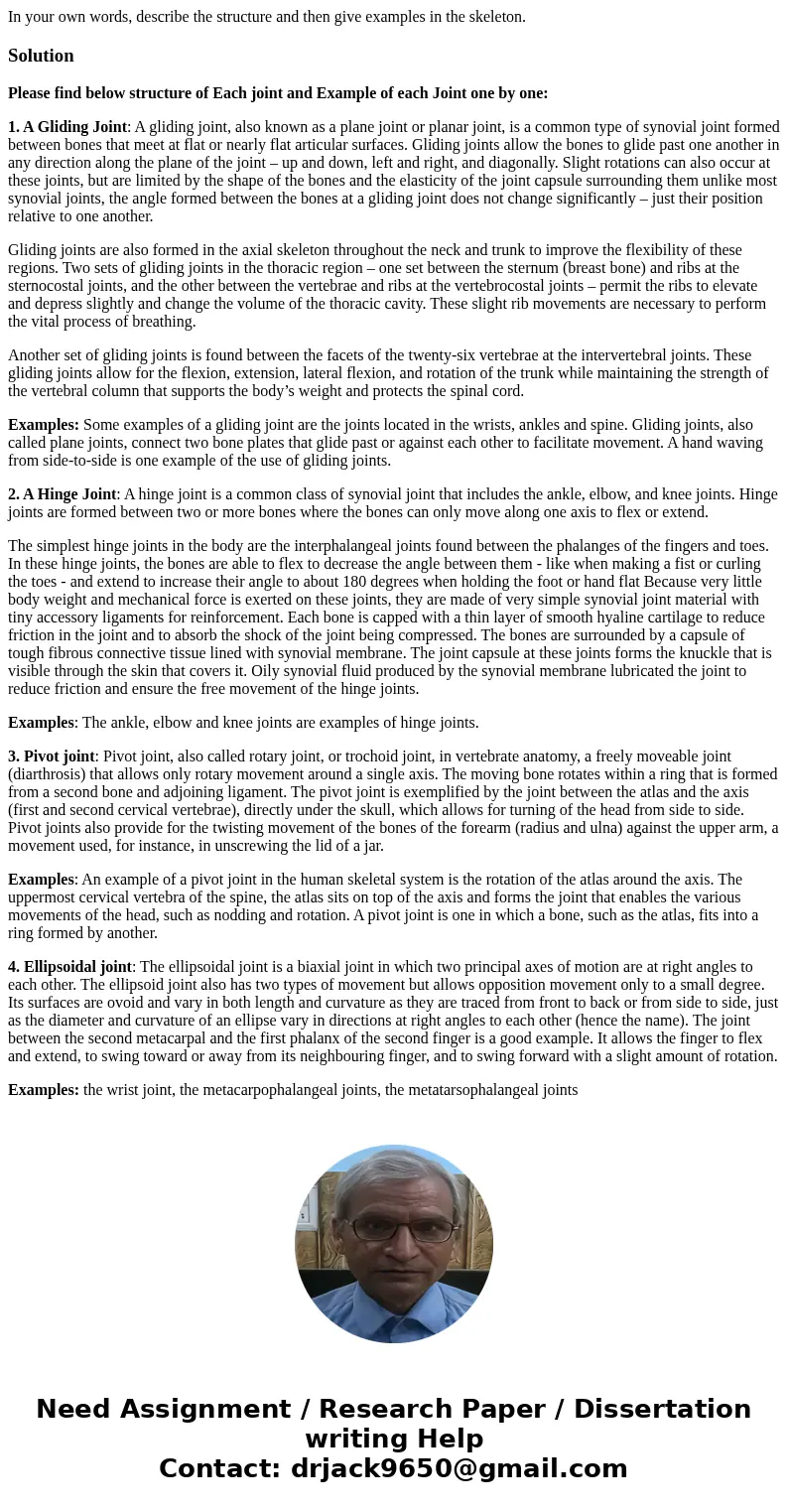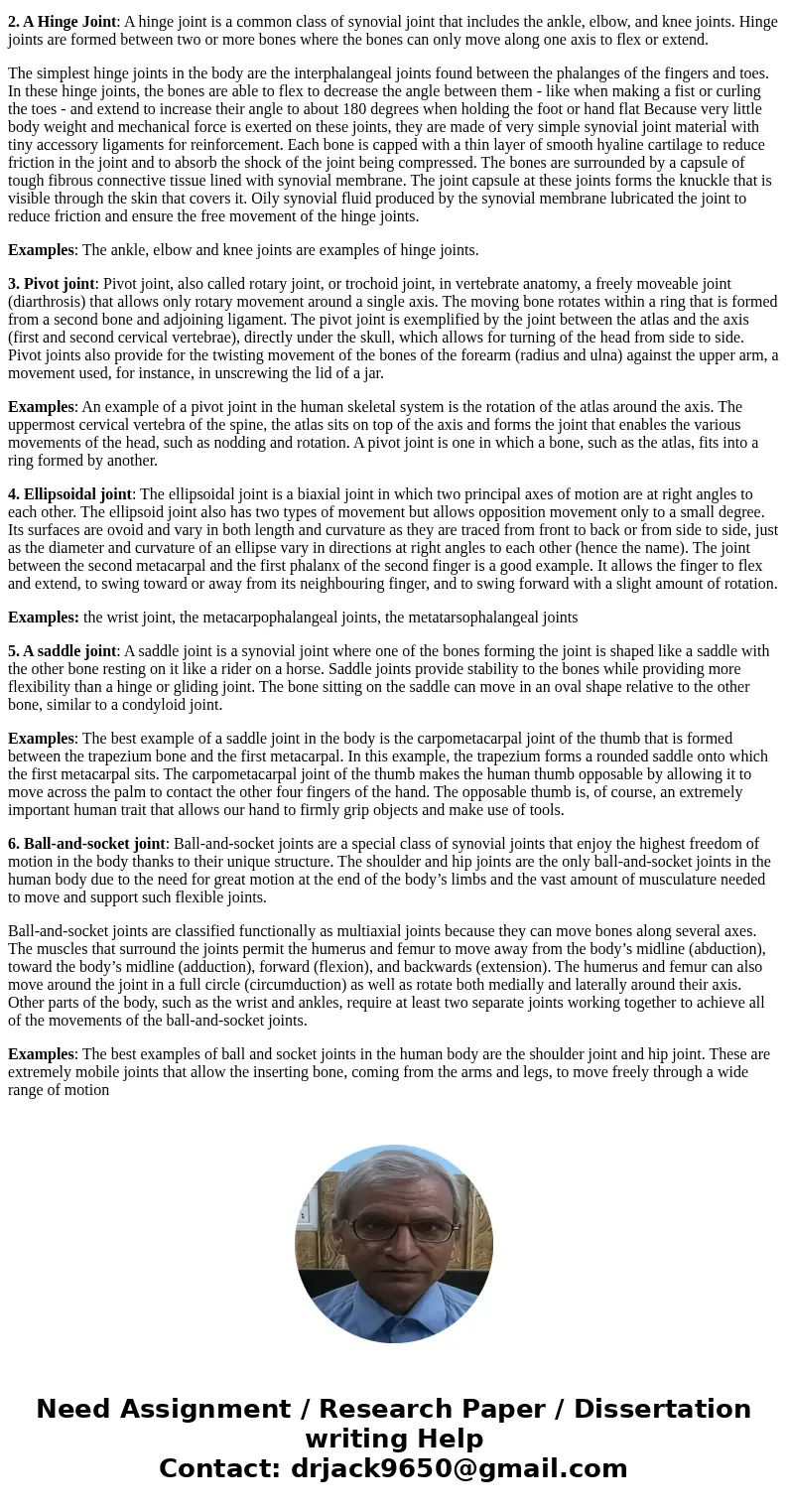In your own words describe the structure and then give examp
Solution
Please find below structure of Each joint and Example of each Joint one by one:
1. A Gliding Joint: A gliding joint, also known as a plane joint or planar joint, is a common type of synovial joint formed between bones that meet at flat or nearly flat articular surfaces. Gliding joints allow the bones to glide past one another in any direction along the plane of the joint – up and down, left and right, and diagonally. Slight rotations can also occur at these joints, but are limited by the shape of the bones and the elasticity of the joint capsule surrounding them unlike most synovial joints, the angle formed between the bones at a gliding joint does not change significantly – just their position relative to one another.
Gliding joints are also formed in the axial skeleton throughout the neck and trunk to improve the flexibility of these regions. Two sets of gliding joints in the thoracic region – one set between the sternum (breast bone) and ribs at the sternocostal joints, and the other between the vertebrae and ribs at the vertebrocostal joints – permit the ribs to elevate and depress slightly and change the volume of the thoracic cavity. These slight rib movements are necessary to perform the vital process of breathing.
Another set of gliding joints is found between the facets of the twenty-six vertebrae at the intervertebral joints. These gliding joints allow for the flexion, extension, lateral flexion, and rotation of the trunk while maintaining the strength of the vertebral column that supports the body’s weight and protects the spinal cord.
Examples: Some examples of a gliding joint are the joints located in the wrists, ankles and spine. Gliding joints, also called plane joints, connect two bone plates that glide past or against each other to facilitate movement. A hand waving from side-to-side is one example of the use of gliding joints.
2. A Hinge Joint: A hinge joint is a common class of synovial joint that includes the ankle, elbow, and knee joints. Hinge joints are formed between two or more bones where the bones can only move along one axis to flex or extend.
The simplest hinge joints in the body are the interphalangeal joints found between the phalanges of the fingers and toes. In these hinge joints, the bones are able to flex to decrease the angle between them - like when making a fist or curling the toes - and extend to increase their angle to about 180 degrees when holding the foot or hand flat Because very little body weight and mechanical force is exerted on these joints, they are made of very simple synovial joint material with tiny accessory ligaments for reinforcement. Each bone is capped with a thin layer of smooth hyaline cartilage to reduce friction in the joint and to absorb the shock of the joint being compressed. The bones are surrounded by a capsule of tough fibrous connective tissue lined with synovial membrane. The joint capsule at these joints forms the knuckle that is visible through the skin that covers it. Oily synovial fluid produced by the synovial membrane lubricated the joint to reduce friction and ensure the free movement of the hinge joints.
Examples: The ankle, elbow and knee joints are examples of hinge joints.
3. Pivot joint: Pivot joint, also called rotary joint, or trochoid joint, in vertebrate anatomy, a freely moveable joint (diarthrosis) that allows only rotary movement around a single axis. The moving bone rotates within a ring that is formed from a second bone and adjoining ligament. The pivot joint is exemplified by the joint between the atlas and the axis (first and second cervical vertebrae), directly under the skull, which allows for turning of the head from side to side. Pivot joints also provide for the twisting movement of the bones of the forearm (radius and ulna) against the upper arm, a movement used, for instance, in unscrewing the lid of a jar.
Examples: An example of a pivot joint in the human skeletal system is the rotation of the atlas around the axis. The uppermost cervical vertebra of the spine, the atlas sits on top of the axis and forms the joint that enables the various movements of the head, such as nodding and rotation. A pivot joint is one in which a bone, such as the atlas, fits into a ring formed by another.
4. Ellipsoidal joint: The ellipsoidal joint is a biaxial joint in which two principal axes of motion are at right angles to each other. The ellipsoid joint also has two types of movement but allows opposition movement only to a small degree. Its surfaces are ovoid and vary in both length and curvature as they are traced from front to back or from side to side, just as the diameter and curvature of an ellipse vary in directions at right angles to each other (hence the name). The joint between the second metacarpal and the first phalanx of the second finger is a good example. It allows the finger to flex and extend, to swing toward or away from its neighbouring finger, and to swing forward with a slight amount of rotation.
Examples: the wrist joint, the metacarpophalangeal joints, the metatarsophalangeal joints
5. A saddle joint: A saddle joint is a synovial joint where one of the bones forming the joint is shaped like a saddle with the other bone resting on it like a rider on a horse. Saddle joints provide stability to the bones while providing more flexibility than a hinge or gliding joint. The bone sitting on the saddle can move in an oval shape relative to the other bone, similar to a condyloid joint.
Examples: The best example of a saddle joint in the body is the carpometacarpal joint of the thumb that is formed between the trapezium bone and the first metacarpal. In this example, the trapezium forms a rounded saddle onto which the first metacarpal sits. The carpometacarpal joint of the thumb makes the human thumb opposable by allowing it to move across the palm to contact the other four fingers of the hand. The opposable thumb is, of course, an extremely important human trait that allows our hand to firmly grip objects and make use of tools.
6. Ball-and-socket joint: Ball-and-socket joints are a special class of synovial joints that enjoy the highest freedom of motion in the body thanks to their unique structure. The shoulder and hip joints are the only ball-and-socket joints in the human body due to the need for great motion at the end of the body’s limbs and the vast amount of musculature needed to move and support such flexible joints.
Ball-and-socket joints are classified functionally as multiaxial joints because they can move bones along several axes. The muscles that surround the joints permit the humerus and femur to move away from the body’s midline (abduction), toward the body’s midline (adduction), forward (flexion), and backwards (extension). The humerus and femur can also move around the joint in a full circle (circumduction) as well as rotate both medially and laterally around their axis. Other parts of the body, such as the wrist and ankles, require at least two separate joints working together to achieve all of the movements of the ball-and-socket joints.
Examples: The best examples of ball and socket joints in the human body are the shoulder joint and hip joint. These are extremely mobile joints that allow the inserting bone, coming from the arms and legs, to move freely through a wide range of motion


 Homework Sourse
Homework Sourse